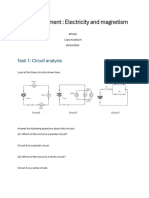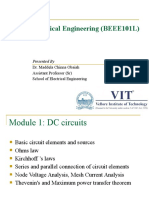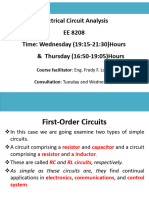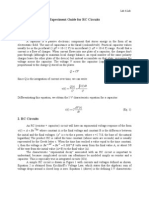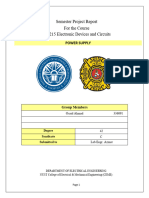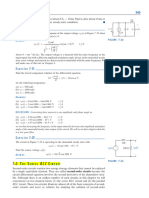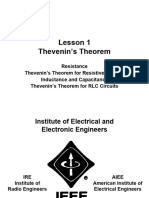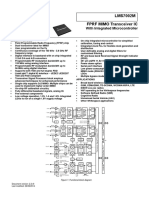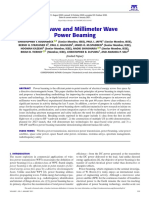Lab 5
Uploaded by
Ross LevineLab 5
Uploaded by
Ross LevineELECTRICAL ENGINEERING DEPARTMENT
California Polytechnic State University
EE 251 DC Transient Response - RC Circuit & DC Steady-State - RLC Circuit Pre-Lab 5
IMPORTANT – SHOW ALL WORK!
1. Show that resistance multiplied by capacitance has units of time.
2. For the circuit shown, at t=0 the switch is closed. R = 40KΩ, C = 0.02µF, Vs = 4 Volts
Note: VO (0) = 0V (initially uncharged)
a. Sketch Vc(t) for 0 ≤ t ≤ 5τ. Label y axis of plot with Vc values at t = τ, 2τ, 3τ, 4τ
and 5τ.
b. How long (ms) is required for the capacitor to reach steady-state?
c. What is the capacitor current at t = τ, t = 3τ, t = steady-state.
o2E 6 40ED 8E 4
140 e
02Mt te
4 p yet y te
it
a
004
I
4I E
3. An initially charged 0.02µF capacitor, VC(0) = 4V, is connected across a 40KΩ resistor.
a. At what time will the voltage across the capacitor equal 2V?
b. At what time will the voltage across the capacitor equal 0.5V?
35
ELECTRICAL ENGINEERING DEPARTMENT
California Polytechnic State University
EE 251 DC Transient Response - RC Circuit & DC Steady-State - RLC Circuit Pre-Lab 5
4. Inductors and capacitors; circle correct answer:
a. At steady-state, an inductor behaves like a/an (short / open) circuit relative to DC
current.
Short
b. At steady-state, a capacitor behaves like a/an (short / open) circuit relative to DC
current.
Open
5. Calculate I and V for the following circuit at steady-state: both resistors in ohms.
I
I I fo IA 25A
I
+
Rea
+
- V
REQ Is t s 20
5 2S s 3 75 V
36
ELECTRICAL ENGINEERING DEPARTMENT
California Polytechnic State University
EE 251 DC Transient Response - RC Circuit & DC Steady-State - RLC Circuit Lab 5
Objective
To investigate DC transient response of a RC circuit and to analyze a RLC circuit at DC steady-
state.
Workbench Equipment
• Function Generator, Agilent 33120A or Agilent 33220A
• DC Power Supply, Agilent E3640A
• Digital Multimeter, Agilent 34401A
• Digital Oscilloscope, Keysight InfiniiVision MSO-X2022A
• Resistor Box II, 10Ω/25Ω/40Ω/130Ω/269Ω/562Ω
• Resistor Decade Boxes, 10 kΩ step
• Inductor Decade Box, 10mH step: 0 – 100mH
• Capacitor Decade Box, 0.01µF step: 0 – 1.1µF
• Impedance Bridge, Gen Rad 1659
Check-out Equipment, 20-111 window
• Scope Probe (10:1), 2
• BNC to banana lead
• Banana to banana, 3 pairs, red/black
• Short leads, quantity 6, 1 bag
Background
Transient Response of RC Circuits
Capacitor Discharging: When an initially charged capacitor is connected to a resistance as shown
in Fig. 5-1, as time progresses, the capacitor’s stored energy is dissipated as heat by the resistor.
As stored energy is released, the voltage across the capacitor plates, as well as charge on the
plates ( V = Cq ) diminishes to zero at steady state. When plate voltage equals zero, there is no
electric field within the dielectric between the plates and stored energy is completely expended.
Fig. 5-1 RC Circuit (Capacitor Discharging)
KCL at top node of Fig. 5-1 with switch closed (t > 0) iC = iR
dVC (t ) dVC (t ) VC (t )
Recall: iC = -C (passive sign convention) C + =0 (5-1)
dt dt R
Current exits the higher voltage plate.
37
dVC (t ) VC (t )
{1st-order homogeneous DEQ} + =0 (5-2)
dt RC
{General solution} VC (t) = Aest (5-3)
Sub general solution into 1st-order homogeneous DEQ
sAest + Aest = 0 (5-4)
RC
1 1 1
Solving for s: (s + ) Aest = 0 -> (s + ) = 0 -> s = - (5-5)
RC RC RC
VC(t) = Ae-t/RC (5-6)
Solve for A at t = 0: VC(0) = Ae-0/RC = A = Vo (5-7)
Natural Response (Due to Stored Energy Only): VC(t) = Voe-t/τ where τ = RC (5-8)
Capacitor voltage (5-8) decays exponentially as time advances. After five time constants (t =
5RC), the capacitor for all practical purposes has reached the steady-state voltage of zero (e-5 =
0.00674) and the capacitor is considered to be depleted of stored energy.
Capacitor Charging: When a source is applied to an RC circuit as shown in Fig. 5-2, VC < VS, the
electrical charge on the capacitor plates increases as time progresses. Therefore, voltage across
the capacitor plates ( V = Cq ) increases as well as charge. This increase in capacitor voltage
produces a stronger (more intense) electric field within the dielectric between the plates and the
capacitor stores increasing energy ( WC = CV 2 ) as time advances until steady-state is achieved.
Fig. 5-2 RC Circuit (Capacitor Charging)
Capacitor initially charged: VC(0) = Vo where Vo < VS
Complete Response = Natural Response + Forced Response
(due to stored energy) (due to independent source)
Natural Response: VC(t) = Voe -t/RC {Derived Previously (5-8)}
KCL at top node of Fig. 5-2 with switch closed (t > 0) iC = iR
dVC (t ) Vs − Vc dVc
Recall: iC = C (passive sign convention) -C =0 (5-9)
dt R dt
Current enters higher voltage plate.
38
dVc Vc Vs
{VS is a constant, DC source} + = (5-10)
dt RC RC
{Forced solution also a constant} VC (t) = XF (5-11)
XF Vs
Sub in XF: 0+ = -> XF = VS (5-12)
RC RC
Complete Response: VC (t) = Ae -t/RC + VS (5-13)
Solve for A at t = 0: VC (0) = Vo = Ae -0/RC + VS -> A = Vo - VS (5-14)
VC (t) = VS + (Vo - VS)e -t/RC (5-15)
VC (t) = Voe -t/RC + VS(1 - e -t/RC) (5-16)
Complete Response = Natural Response + Forced Response
(due to stored energy) (due to independent source)
For initially uncharged Capacitor: Vo = 0 VC (t) = VS(1 - e -t/RC) (5-17)
As can be seen from (5-17), for all practical purposes, capacitor voltage increases from zero volts
to a steady-state value of Vs after five time constants (1 - e-5 = 0.99326) and the capacitor is
considered to be fully charged.
Capacitors & Inductors Under DC Steady-State Conditions
Inductors and capacitors have the following voltage – current relations:
dI (t )
VL = L (5-18)
dt
dV (t )
IC = C (5-19)
dt
For DC circuits, all time derivatives are zero since all currents and voltages are constant.
Therefore, under DC conditions:
V L = 0 for any current (same V-I relation as zero ohms = short) (5-20)
I C = 0 for any voltage (same V-I relation as infinite ohms = open) (5-21)
Hence, for DC conditions, inductors “act” as short-circuits and capacitors “act” as open-circuits.
Oscilloscope Basics
To view the transient response of an RC circuit, an oscilloscope (“scope”) is used. A scope
converts an electrical signal into a visible trace on a display screen. The display screen is a graph
of voltage (vertical axis) versus time (horizontal axis). Vertical grid lines (or divisions) on the
display screen have numerical values relative to the volts per division setting; horizontal screen
divisions have numerical values relative to the time per division setting. Both settings can be
manually adjusted or the Auto-Scale button can be pressed and the scope will automatically set
the volts per division setting and time per division setting for optimum signal visibility, see Fig.
5-3 for an example of a displayed sinusoidal voltage.
39
500us per horizontal division
1V per vertical division division
division
Fig. 5-3 Volts per Vertical Division & Time per Horizontal Division
A common scope measurement method is to use vertical cursors (dashed lines) to measure signal
amplitude such as peak or peak-to-peak or to use horizontal cursors (dashed lines) to measure the
time difference between two points on a signal such as measuring period, see Fig. 5-4.
Vpp Period
Frequency
Delta X = Period
Delta Y = Vpp
Fig. 5-4 Measuring Amplitude & Time Difference with Cursors
In addition, the Keysight scope has a feature, Meas (button below the horizontal position knob),
that automatically displays amplitude, period, and /or frequency, as well as many other signal
parameters without the use of cursors.
Most often, a scope probe is used to transfer the signal under test to the scope input. The most
popular scope probe (and used in this lab) is the 10:1 scope probe. The ratio 10:1 refers to the
factor of attenuation (loss) between the scope probe tip and the scope input. For example, if the
scope probe is connected to a 10 Vpeak signal, the signal amplitude at the scope input is 1 Vpeak. In
other words, the scope probe has attenuated (decreased amplitude) by a factor of ten.
The scope has a probe adjust setting which compensates for this loss in amplitude; the displayed
amplitude matches the signal amplitude at the scope tip.
A BNC to BNC lead or BNC to banana lead can also be used to connect a signal to a scope input.
These leads have minimal attenuation and are considered ideally to be shorts. The main
advantage a scope probe has over a lead is higher input impedance which means less loading.
Recall from experiment one; an ideal voltmeter has infinite internal resistance. Scopes can be
thought of as sophisticated voltmeters and likewise have ideal infinite internal resistance /
impedance.
40
Scopes commonly have multiple inputs (also called channels) allowing multiple simultaneous
signals to be displayed. Our lab scopes are dual channel (two inputs) and in this experiment one
input will be used as a “triggering” source or signal.
Scope triggering can be thought of as synchronized picture taking. A signal displayed (“picture”)
on a scope screen is the result of many consecutive digitized samples. This process of picture
taking (i.e. producing signal on scope screen) must be synchronized to a unique point on a
waveform that repeats, otherwise the displayed signal becomes unstable. The triggering source
provides the unique point, most often the triggering signal has a sharp transition, such as a square
wave does, and either the high to low transition (falling-edge or trailing-edge) or the low to high
transition (rising-edge or leading-edge) is used as the unique point for synchronization.
Procedure 1: RC Transient Response
• Use impedance bridge set at 100 Hz to measure capacitor value and use ohmmeter to
measure resistor value used to construct circuit of Fig. 5-5 and record in Table 5-1.
• Set function generator (FG) to high-Z output:
To set Agilent 33120A function generator to high-Z output:
o Press shift-menu, right arrow to the SYS menu, down arrow to the OUTPUT TERM
menu, down arrow to ‘50 ohms,’ right arrow to select Hi Z, enter.
To set Agilent 33220A function generator to high-Z output:
o Press Utility, then choose Output Setup, select High Z.
• Set function generator to a square wave output with a minimum value of 0 V and a maximum
value of 4 V (amplitude = 4Vpp with DC offset = 2V). Set frequency of square wave to
100Hz and use a duty cycle of 50%.
o Duty cycle refers to the amount of time a square wave is equal to its largest amplitude
(4V in this case) compared to its period.
• Connect channel 1 scope probe between node A and ground (black clip to ground).
• Connect channel 2 scope probe between node B and ground (black clip to ground).
• NOTE: Probe adjust needs to be set to 10:1!
• To check probe adjust: Press channel button, channel menu appears at bottom of scope
screen and then press Probe soft key. Probe ratio will appear at bottom of screen to the
right of Units.
• To adjust probe adjust: Turn knob located directly below time per division knob.
• Set both scope channels to DC coupling (on channel menu) and set both channel vertical
sensitivity to 1V/div.
• Set horizontal sensitivity to 1millisec/division.
• Set trigger settings as follows:
o Press Mode Coupling button and select auto.
o Press Trigger button and choose Source 1 and rising edge .
o Note: May need to adjust Trigger Level knob to stabilize displayed signal. Adjust
Trigger Level until horizontal line with T at far left is within the amplitude of
source square-wave signal. If signal is still unstable, consult instructor.
• Use cursors to determine time constant of Vc during charging, may need to change horizontal
sensitivity for accuracy, and record in Table 5-1.
• Capture scope display of Vc using Keysight BenchVue desktop icon (ask instructor for steps
after double-clicking icon).
41
• Observe the effect on the charge curve as R is changed to 30KΩ and then changed to 50KΩ.
o Capture scope displays for both above R values to help answer a post-lab
question.
• Set R back to 40KΩ and change square wave to a minimum value of 0 V and a maximum
value of 5 V.
o Observe effect this has on charge curve and capture to help answer a post-lab
question.
• Change Source 1 trigger setting to falling edge and determine time constant of Vc during
discharging and record in Table 5-1.
• Capture scope display of Vc.
• Observe the effect on the discharge curve as R is changed to 30KΩ and then changed to
50KΩ.
o Capture scope displays for both R values to answer a post-lab question.
• Set R back to 40KΩ and change square wave to a minimum value of 0 V and a maximum
value of 5 V.
o Observe effect on discharge curve and capture to answer a post-lab question.
• Calculate percent error between theoretical (done in prelab #2 & #3) and experimental
charging and discharging time constants. Record in Table 5-1.
RE 4454.021nF
D
Set to Hi Z
Fig. 5-5 RC Transient Circuit
R(40KΩ) (Ω) C(0.02µF) (µF)
Measured
Charging (µs) Discharging (µs)
Measured Time
Constant
Calculated Time
Constant
Percent Error (%)
Table 5-1 R & C Measured Values / RC Transient Time Constant Measurements & Calculations
Procedure 2: Capacitors & Inductors at DC Steady-state
• Measure all resistors (Ω) used to construct the circuit of Fig. 5-6 and record in Table 5-2a.
• Calculate and record REQ at nodes a-b using ideal DC equivalents for inductors (short) and
capacitors (open).
• Construct the circuit of Fig. 5-6, except for the voltage source (power supply).
• Measure the open circuit resistance across terminals a-b. This yields the equivalent resistance
REQ.
42
+
40088 µ
- 99.008 0928,66
Fig. 5-6 Capacitors & Inductors at DC steady-state Circuit
Resistances R1 (25Ω) (Ω) R2 (10Ω) (Ω) R3 (130Ω) (Ω) REQ = Rab (Ω)
Measured
Calculated Rab = Percent Error Rab =
Table 5-2a DC Inductor and Capacitor Circuit: Resistance Measurements
• Calculate the voltage across each resistor using ideal DC equivalents for inductors (short)
and capacitors (open). Record calculated voltages in Table 5-2b
• Connect the 10V power supply (0.5A current limit) and measure the voltages across each
resistor. Record measured voltages in Table 5-2b.
• Calculate percent error between measured and calculated voltages and record in Table 5-2b.
R1 (25Ω) R2 (10Ω) R3 (130Ω)
Measured Voltage (V)
Calculated Voltage (V)
Percent Error (%)
Table 5-2b DC Inductor and Capacitor Circuit: Voltage Measurements and Calculations
Discussion
1. In Procedure 1, for all practical purposes, how long (in ms) does it take for the capacitor to
fully discharge? Use measured values.
2. Describe the effect changing R in procedure 1 had on charging and discharging curves.
3. For procedure 1, describe the effect changing square wave amplitude from 0V to 5V had on
charging and discharging curves.
4. In Procedure 1 when R = 40KΩ and the square wave has minimum value 0V and maximum
value 5V, if the frequency of the square wave is increased to 200 Hz, will the capacitor
charge fully to 5V? Why or why not?
5. In Procedure 2, what is the primary reason for differences between measured and calculated
values of resistor voltages? Hint: non-ideal storage element.
43
1) 5 ms
2) In procedure 1, increasing the Resistance made the waves more and more flat while decreasing the resistance made the
waves more and more square shaped.
3)
4) No it won’t, because the capacitor would not have enough time to reach steady state. In other words, if the voltage begins
decreasing while the capacitor is still transient, then the ca
You might also like
- Course Outline General Biology II: Course Code (S) and Mesrs Objectives Science (200.B0), Registered in 101-LCU-05No ratings yetCourse Outline General Biology II: Course Code (S) and Mesrs Objectives Science (200.B0), Registered in 101-LCU-0512 pages
- Chemistry 202-Nyb Winter 2007 Instructor: Michael Lautman Section 07 Class Test 3 - Salmon NameNo ratings yetChemistry 202-Nyb Winter 2007 Instructor: Michael Lautman Section 07 Class Test 3 - Salmon Name6 pages
- Here Are Some Logic Gate Circuit ProblemsNo ratings yetHere Are Some Logic Gate Circuit Problems7 pages
- Electric Charge AND Field: PHY 334 Fundamental of Physics, Electricity, Magnetism and OpticsNo ratings yetElectric Charge AND Field: PHY 334 Fundamental of Physics, Electricity, Magnetism and Optics108 pages
- DC CIRCUITS - Second Order Circuits - Brief ExplanationNo ratings yetDC CIRCUITS - Second Order Circuits - Brief Explanation22 pages
- Basic Electrical Engineering (BEEE101L) : Presented byNo ratings yetBasic Electrical Engineering (BEEE101L) : Presented by22 pages
- Energy Bands For Electrons in Crystals (Kittel Ch. 7)No ratings yetEnergy Bands For Electrons in Crystals (Kittel Ch. 7)39 pages
- Name: Muhammad Nadeem Registration No: Course NameNo ratings yetName: Muhammad Nadeem Registration No: Course Name5 pages
- Fundamentals Grady Notes June 2007 PrintNo ratings yetFundamentals Grady Notes June 2007 Print389 pages
- Chapter 32. Alternating-Current Circuits: The CapacitorNo ratings yetChapter 32. Alternating-Current Circuits: The Capacitor19 pages
- Set 5_Response of Circuits Having Energy Storing Elements_First OrderNo ratings yetSet 5_Response of Circuits Having Energy Storing Elements_First Order22 pages
- Experiment Guide For RC Circuits 1. CapacitorsNo ratings yetExperiment Guide For RC Circuits 1. Capacitors9 pages
- Some Applications of Differential Equations in RL-RC Electrical CircuitNo ratings yetSome Applications of Differential Equations in RL-RC Electrical Circuit12 pages
- Lab11-ManualSeries20RLC20circuit20excited20by20step20function20and20AC20signalENNo ratings yetLab11-ManualSeries20RLC20circuit20excited20by20step20function20and20AC20signalEN11 pages
- DC-Transients-Analysis-Short-Version-24-25-1SNo ratings yetDC-Transients-Analysis-Short-Version-24-25-1S10 pages
- Experiment: Transient Response of An RC CircuitNo ratings yetExperiment: Transient Response of An RC Circuit7 pages
- Reading:: Electric Circuits (EET1411) HW11No ratings yetReading:: Electric Circuits (EET1411) HW114 pages
- RC Circuits and The Oscilloscope: ObjectiveNo ratings yetRC Circuits and The Oscilloscope: Objective13 pages
- Physics 15b, Lab 3: The Capacitor, and A Glimpse of Diodes: Q CV I INo ratings yetPhysics 15b, Lab 3: The Capacitor, and A Glimpse of Diodes: Q CV I I7 pages
- L5 - Transient Response (Forced Response)No ratings yetL5 - Transient Response (Forced Response)43 pages
- Critical Challenges in Enterprise Resource Planning (ERP) Implementation100% (1)Critical Challenges in Enterprise Resource Planning (ERP) Implementation16 pages
- Enterprise Resource Planning Global OpportunitiesNo ratings yetEnterprise Resource Planning Global Opportunities256 pages
- European Journal of Operational Research: Chung-Hsing Yeh, Yan XuNo ratings yetEuropean Journal of Operational Research: Chung-Hsing Yeh, Yan Xu11 pages
- Cal Poly Arts Presents Eddie Izzard Believe Me Tour Performing Arts Center 1 Grand Ave., SLO, CANo ratings yetCal Poly Arts Presents Eddie Izzard Believe Me Tour Performing Arts Center 1 Grand Ave., SLO, CA1 page
- Shit Instantly Bryan: That Suggest They'reNo ratings yetShit Instantly Bryan: That Suggest They're3 pages
- 1 What Do You Think Life in The Future Will Look Like ? (Say 20 Years From Now)No ratings yet1 What Do You Think Life in The Future Will Look Like ? (Say 20 Years From Now)1 page
- Instant ebooks textbook Aircraft Communications and Navigation Systems, 3rd edition Mike Tooley & David Wyatt download all chapters100% (1)Instant ebooks textbook Aircraft Communications and Navigation Systems, 3rd edition Mike Tooley & David Wyatt download all chapters65 pages
- Project 14 - Transmission Line Design and Layout in ADS (October 2013)No ratings yetProject 14 - Transmission Line Design and Layout in ADS (October 2013)15 pages
- 1.discuss The Frequency Domain Techniques of Image Enhancement in DetailNo ratings yet1.discuss The Frequency Domain Techniques of Image Enhancement in Detail19 pages
- DT081A - Signal and Image Processing Lab 1 ReportNo ratings yetDT081A - Signal and Image Processing Lab 1 Report20 pages
- ERAN Feature Documentation ERAN16.1 - 10 20230721170353No ratings yetERAN Feature Documentation ERAN16.1 - 10 20230721170353331 pages
- Wireless Communication and Mobile ComputingNo ratings yetWireless Communication and Mobile Computing64 pages
- A Reference Oversampling Digital Phase-Locked Loop With - 240 DB FOM and - 80 DBC Reference SpurNo ratings yetA Reference Oversampling Digital Phase-Locked Loop With - 240 DB FOM and - 80 DBC Reference Spur2 pages
- A Wideband HEMT Cascode Low-Noise Amplifier With HBT Bias RegulationNo ratings yetA Wideband HEMT Cascode Low-Noise Amplifier With HBT Bias Regulation3 pages
- A Transformer-Based OFDM Receiver For Underwater Acoustic CommunicationNo ratings yetA Transformer-Based OFDM Receiver For Underwater Acoustic Communication5 pages
- Microwave and Millimeter Wave Power BeamingNo ratings yetMicrowave and Millimeter Wave Power Beaming31 pages
- Aditya College of Engineering & TechnologyNo ratings yetAditya College of Engineering & Technology1 page
- Course Outline General Biology II: Course Code (S) and Mesrs Objectives Science (200.B0), Registered in 101-LCU-05Course Outline General Biology II: Course Code (S) and Mesrs Objectives Science (200.B0), Registered in 101-LCU-05
- Chemistry 202-Nyb Winter 2007 Instructor: Michael Lautman Section 07 Class Test 3 - Salmon NameChemistry 202-Nyb Winter 2007 Instructor: Michael Lautman Section 07 Class Test 3 - Salmon Name
- Electric Charge AND Field: PHY 334 Fundamental of Physics, Electricity, Magnetism and OpticsElectric Charge AND Field: PHY 334 Fundamental of Physics, Electricity, Magnetism and Optics
- DC CIRCUITS - Second Order Circuits - Brief ExplanationDC CIRCUITS - Second Order Circuits - Brief Explanation
- Basic Electrical Engineering (BEEE101L) : Presented byBasic Electrical Engineering (BEEE101L) : Presented by
- Energy Bands For Electrons in Crystals (Kittel Ch. 7)Energy Bands For Electrons in Crystals (Kittel Ch. 7)
- Name: Muhammad Nadeem Registration No: Course NameName: Muhammad Nadeem Registration No: Course Name
- Chapter 32. Alternating-Current Circuits: The CapacitorChapter 32. Alternating-Current Circuits: The Capacitor
- Set 5_Response of Circuits Having Energy Storing Elements_First OrderSet 5_Response of Circuits Having Energy Storing Elements_First Order
- Some Applications of Differential Equations in RL-RC Electrical CircuitSome Applications of Differential Equations in RL-RC Electrical Circuit
- Lab11-ManualSeries20RLC20circuit20excited20by20step20function20and20AC20signalENLab11-ManualSeries20RLC20circuit20excited20by20step20function20and20AC20signalEN
- Physics 15b, Lab 3: The Capacitor, and A Glimpse of Diodes: Q CV I IPhysics 15b, Lab 3: The Capacitor, and A Glimpse of Diodes: Q CV I I
- Critical Challenges in Enterprise Resource Planning (ERP) ImplementationCritical Challenges in Enterprise Resource Planning (ERP) Implementation
- European Journal of Operational Research: Chung-Hsing Yeh, Yan XuEuropean Journal of Operational Research: Chung-Hsing Yeh, Yan Xu
- Cal Poly Arts Presents Eddie Izzard Believe Me Tour Performing Arts Center 1 Grand Ave., SLO, CACal Poly Arts Presents Eddie Izzard Believe Me Tour Performing Arts Center 1 Grand Ave., SLO, CA
- 1 What Do You Think Life in The Future Will Look Like ? (Say 20 Years From Now)1 What Do You Think Life in The Future Will Look Like ? (Say 20 Years From Now)
- Instant ebooks textbook Aircraft Communications and Navigation Systems, 3rd edition Mike Tooley & David Wyatt download all chaptersInstant ebooks textbook Aircraft Communications and Navigation Systems, 3rd edition Mike Tooley & David Wyatt download all chapters
- Project 14 - Transmission Line Design and Layout in ADS (October 2013)Project 14 - Transmission Line Design and Layout in ADS (October 2013)
- 1.discuss The Frequency Domain Techniques of Image Enhancement in Detail1.discuss The Frequency Domain Techniques of Image Enhancement in Detail
- ERAN Feature Documentation ERAN16.1 - 10 20230721170353ERAN Feature Documentation ERAN16.1 - 10 20230721170353
- A Reference Oversampling Digital Phase-Locked Loop With - 240 DB FOM and - 80 DBC Reference SpurA Reference Oversampling Digital Phase-Locked Loop With - 240 DB FOM and - 80 DBC Reference Spur
- A Wideband HEMT Cascode Low-Noise Amplifier With HBT Bias RegulationA Wideband HEMT Cascode Low-Noise Amplifier With HBT Bias Regulation
- A Transformer-Based OFDM Receiver For Underwater Acoustic CommunicationA Transformer-Based OFDM Receiver For Underwater Acoustic Communication












